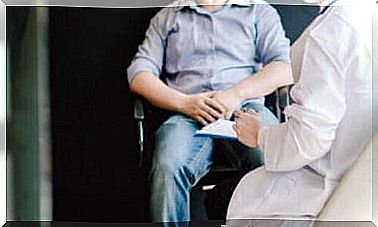Assaulted Woman Syndrome

The syndrome of a battered woman affects only a person who has experienced long-term physical or mental assault. This is a term coined by Lenore EA Walker.
Her book The battered woman syndrome describes all the physical symptoms and mental consequences of being beaten in a relationship. There is also a special section in the book dedicated to cases where children are involved.
Identification of the battered woman’s syndrome

The syndrome of an abused woman contains clear characteristics that everyone should be able to identify.
Why?
People with the syndrome should seek professional help as soon as possible. Thus, the symptoms do not progress or end up affecting the quality of life of the surviving victim.
These include:
- Physical symptoms such as insomnia, weight loss, emotional somatization in the form of eczema, migraines, seizures and so on.
- Psychological symptoms such as depression, low self-esteem, guilt, hopelessness and fear.
These are just some of the symptoms that people suffering from battered woman syndrome may experience. However, there are many other things that should be considered at the individual level.
Let’s look at some of them, and examine the steps to follow to reduce trauma.
Learned helplessness
It is a psychological condition that usually occurs in people who have been beaten by someone they have trusted. It is a detrimental consequence that prevents people from making decisions on their own behalf. Such a person fails to defend himself or to get out of situations where he is violent.
In this case, the person believes that nothing he does will affect the outcome.
While it may seem easy to get over it, it is a state of extreme disability. Indeed, learned helplessness is the main reason why many people remain in a violent situation.
Failure to treat it can make a person an easy victim to another assailant.
Traumatic stress

When a person has been exposed to repeated assault for a long time, he or she has been under constant stress. This prolonged stress persists even after leaving the situation.
To identify traumatic stress, it is important to analyze the behavior of the victim of assault, which includes, for example:
- Nightmares and setbacks that lead to night sweats, fear and anxiety.
- Avoiding places, people, or thoughts that remind him or her of an assault situation.
- Over-vigilance, especially on the street, because the victim thinks his abuser is following him.
- Difficulty remembering certain moments of traumatic events.
It is often difficult for all people who have experienced violent situations to get over the setbacks. Their traumatic stress is based on the idea that their perpetrators will overcome and pull them back to their former violent situation.
Getting help
The victim of the assault may believe he or she will not be able to get help and recover.
Yes, it is true that in many cases, the abuser returns after receiving only a restraining order. This is scary. And you usually can’t control it yourself.
However, it is also true that it is entirely possible to take responsibility for one’s own life, take distance, and heal from any form of abuse or trauma.
Now let’s look at what you can do about it:
Doctor, dentist, priest or child’s school authorities
All of these people have a responsibility to report the violence they perceive. Usually, they have some form of training related to domestic violence problems.
They should be able to help the victim get out of the domestic violence situation by contacting the organizations that provide help.
Please note that most of the information you give to your doctor or priest is confidential. Those people must also report child abuse.
Legal aid
Lawyers who specialize in family law usually have connections to the resources available to help them in cases of domestic violence. They can also help you create a plan to get rid of the abuser safely as well as help you get a temporary restraining order.
If you cannot afford a lawyer, contact the city’s legal aid organization to find out if you have access to a free representative.
Shelters
There are many different non-profit organizations dedicated to helping people cope with domestic violence.
Therapy
Turning to a therapist is one of the best and healthiest ways to help you heal and move on.
Find a Therapist near you. If money is an issue, discuss your options with your local help centers. Make sure you get the help you — or your child — deserve to move forward, live a healthy life, and ensure that assault remains a problem of the past.
Helpful phone
There are telephone services that anyone can call and share their experiences, ask for help, or apply for a chat club. They are available for both children and adults. It’s a free service and can be a really great help in situations where a person feels depressed and even considers suicide.
When you are in a violent situation, do not hesitate to call the emergency number 112. The police can help in cases of domestic violence by providing a safe place to live while they investigate the case. They can also provide other support, such as employment services and a lawyer.
No one should tolerate violence, and there are many ways to get out of it, although the first step may seem difficult.









